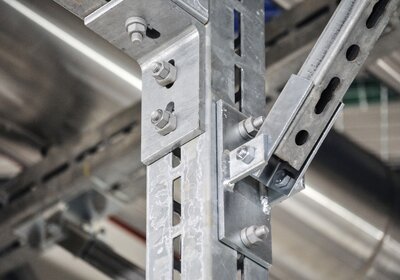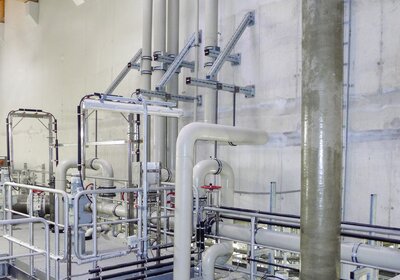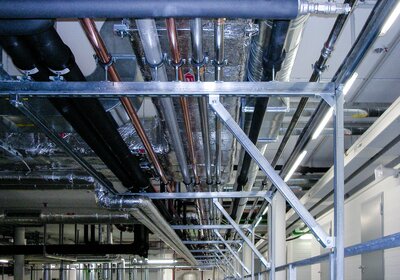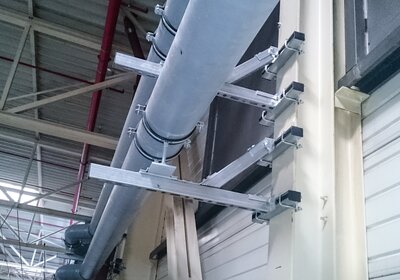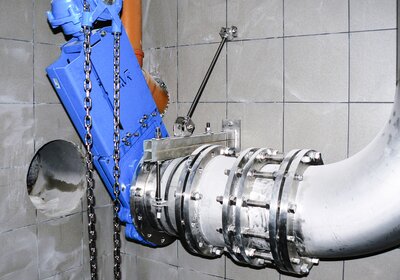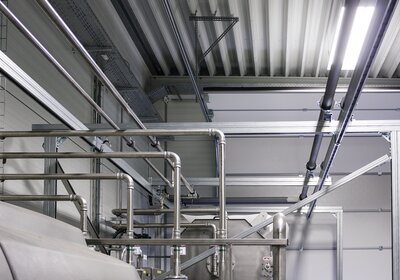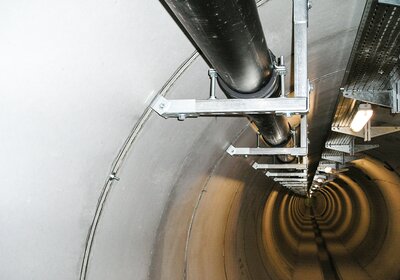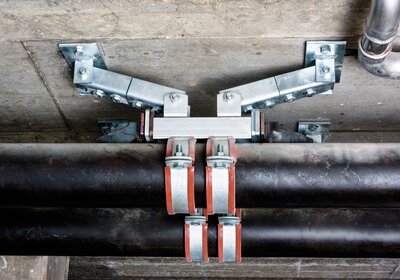Stabilize structures with joint connections
15 March 2022 , MEFA blog team
When large forces occur and weight or material is to be saved, lightweight construction is the order of the day. The classic method is a truss structure: Everyone is familiar with railroad bridges made of steel and rivets or structures from the time of the World's Fairs starting in 1851, such as the Crystal Palace in London or the Eiffel Tower. The principle is based on steel beams on the outer and inner edges of the structures, which transmit tensile and compressive forces, and braces, which give the construction a stable structure. The advantages of this classic lightweight construction method can also be transferred to pipe fixings.
In industrial construction in particular, truss-like superstructures made of profile rails can help to bridge large spans, realize stiffening or minimize movements of supporting structures. Here, the diagonal bars usually assume the function of a compression or tension bar. In order to adapt the angular adjustment of the bars exactly to the requirements, so-called joint connectors are suitable, which are available for a wide variety of applications.
Which type for which application?
Joint holder with baseplate: A hinge joint is welded onto a rectangular baseplate, which is fixed to the substrate with anchors, either longitudinally or transversely. This joint connects the baseplate to a U-shaped steel profile, which is used to hold a profile rail. With this joint holder, bracing in the angular range from 0 to 90° can be realized. We offer these products in two basic sizes for the profile rails 35 and 45 as well as for the heavy-duty system CENTUM®.
Example of a joint holder with baseplate as a fixing element of a brace. The baseplate enables fixing to the wall with anchors or a screw connection to profile rails.
Suspension of pipelines in the heavy-duty area in a power station: The joint holders with baseplate ensure high load-bearing capacity and a firm bond with the concrete wall.
Joint holder for connection to profile rails: With this second type, there is a profile connection for fixing to a profile rail instead of a baseplate - also for profile type 35, 45 and CENTUM®. With this product, especially rail constructions of all kinds can be realized. These accessories are also ideally suited for the construction of freestanding racks or scaffolds with braces for stiffening.
This brace uses joint holders for the direct connection to profile rails. Here, mounting accessories can be used preferentially to save time.
Pipe fixing to steel beams with retaining clips: With braces, the fixing to the steel beam without drilling or welding has a higher load capacity by doubling the number of retaining clips.
Joint holder with terminal hole: This variant is primarily used for the individual suspension of pipelines with threaded rods. The joint holder can be attached either to profile rails or directly to the building ground. On the other side, there is only a hole for fixing the threaded rod. An application example is the pipeline mounting on inclined profile rails or corresponding roof and floor constructions.
A bracing for the transmission of tensile forces via two joint holders with terminal hole. Bending moments and compressive forces can only be transmitted to a limited extent or not at all via such a construction.
Joint connection for profile rails: It is also possible to connect two profile rails that are to be positioned at any angle to each other. As a simple variant, we offer here the flat joint connection for profile rails. More lateral support is provided by the profile joint connection, which is equipped with two angle profiles for holding the profile rails. The rail position can be freely selected.
Application example for a joint connection for profile rails in the flat version. This connection can also be used to connect two profile rails in series and at any angle to each other.
Joint angle: Finally, there is a solution for threaded tie rods. This is the joint angle for fixing to profile rails or directly to the substrate for bracing with M12 threaded rods.
Depending on the indoor or outdoor application, the joint connections are available with corrosion-resistant surfaces and in stainless steel. Another important point is the retrofitting capability: If subsequent stiffening of a structure or the absorption of higher loads by additional pipelines is required, braces and supports with joint connections can be retrofitted without any problems. The requirement is, of course, a system solution for profiled bars and accessories. With us, the rail systems 35, 45 and CENTUM® can be combined with each other as desired.
Solutions for round and sloping walls
Sloping roof structures were already mentioned. However, there are other cases where connections to the building structure are required at any angle. These are tunnel constructions or utility shafts, which often have curved walls. Safe pipeline installation without a wide range of joint connections is hardly possible here.
In some precast concrete elements, appropriately curved profile rails are already cast in for the pipeline installation. Here, too, quick and easy installation is possible with joint holders.
Fixpoint constructions
Another special case are fixpoints for pipelines on sloping walls. For this purpose, we offer the fixpoint type A with joint holder. The fixpoint is firmly connected to the building by means of two joint holders. Thanks to the freely adjustable angles, installation on sloping ceilings is just as possible as on stepped ceiling constructions.
In principle, the dimensioning of suspensions and bracing is, of course, a question of strength calculation. Should this become too complex for the planner or the installation company in one or the other case, the support of the MEFA application engineering is available with advice and assistance.
A practical special construction is the fixpoint type A with joint holders, which enables a fixpoint even with sloping ceilings via different attack angles.

